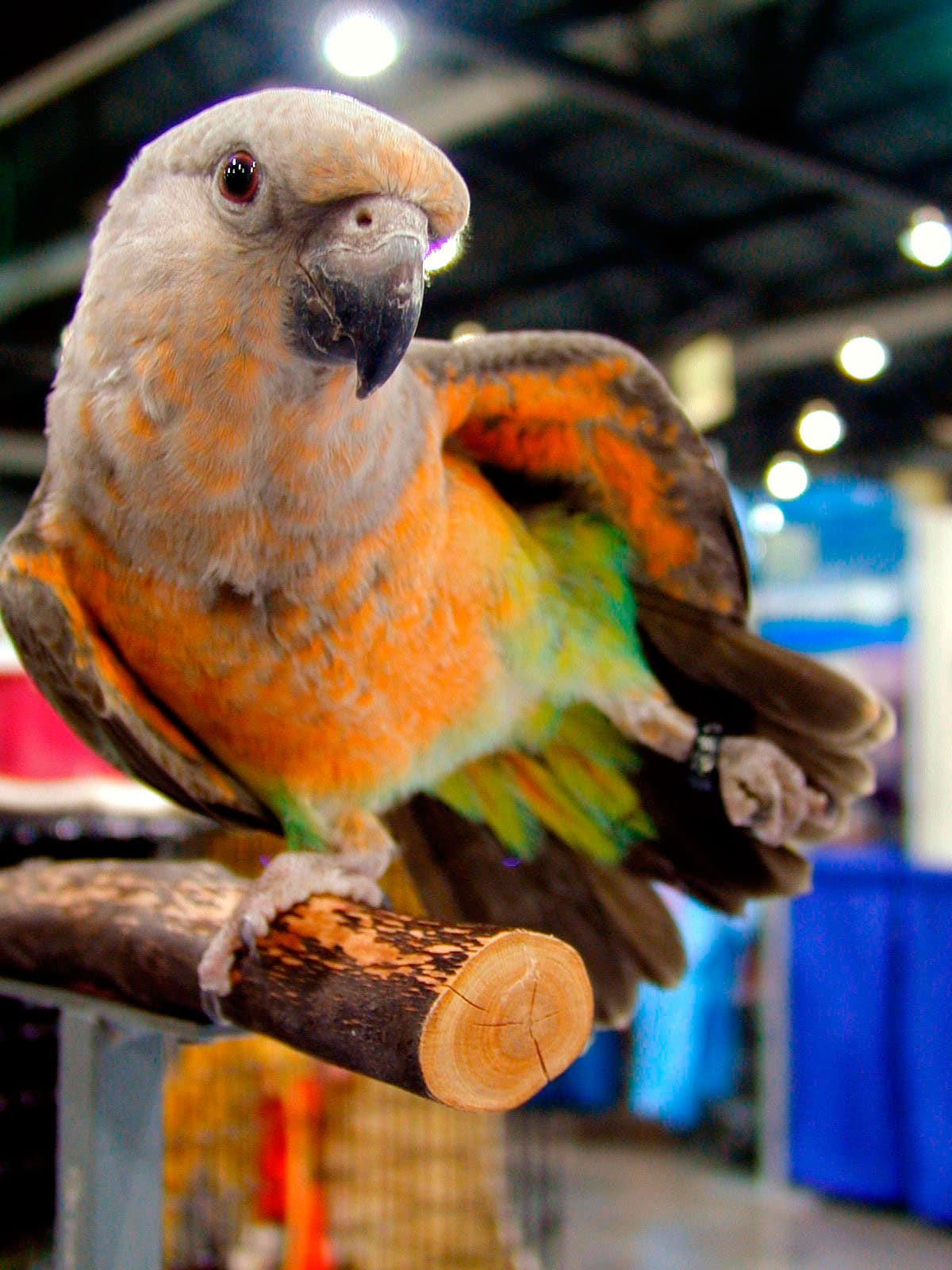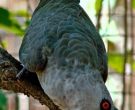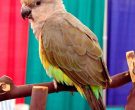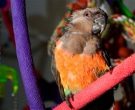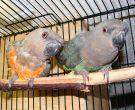Content |
|---|
Description:
22 cm.. length and an average weight of 130 g..
The Red-bellied Parrot (Poicephalus rufiventris) has the crown, nape and lores brown ash, the cheeks sometimes with orange tips; ear-coverts slightly paler. Mantle and scapulars brown ash; the back blue-black; rump iridescent pale blue or bluish green. Upper, the wings slightly darker than the head and back: the primaries brown. Under, the feathers of orange wings; underside of feathers Light brown flight. Throat and the chest ash brown with orange tint; top of the chest orange; belly up to undertail- coverts pale green sometimes shows Orange-tinged feathers. Tail dark brown ash.
Bill, cere and orbital skin black; irises orange-red; legs black.
The female You have the upper chest grey, the pale green underside sometimes dyed orange. The head paler and grayer than male. Feathers of the wings greyish.
Immature, generally, similar to females, but the young males have orange feathers Wings below and can show brown marks on the chest.
- Sound of the Red-bellied Parrot.
Description 2 subspecies:
-
(Someren, 1922) – head of color Brown and throat clearer than the one of the species nominal..
Poicephalus rufiventris pallidus
-
(Ruppell, 1842) – The species nominal.
Poicephalus rufiventris rufiventris
Habitat:
Usually associated with semiarid vegetation, including areas of dry scrub and forest steppe Acacia Commiphora. It tends to avoid the dense foliage and, often it perches on dead branches.
In the south of the range, He prefers savannas Adansonia.
Where it is sympatric with the Meyer's Parrot (West range) the Red-bellied Parrot riparian forests and avoid living in the most open savannas.
In Ethiopia They can be observed in areas of savannah Acacia-Chrysopogon, up to 2,000m. altitude.
In Somalia They are subject to seasonal altitudinal movements in relation to the food supply, moving in altitude of about 2,000m from July to September in search of wild figs Ficus. Otherwise, generally below 1,400m.
Usually, seen in pairs or in family groups 3-4 birds; rarely in larger flocks.
Reproduction:
Nest in cavities within terrestrial termite mounds, between 2 and 3 meters above ground or 10 meters or more, in some dead tree.
The female incubates the eggs while the male goes in search of food, these eggs hatch after a few 28 days and start flying to the 60 days after hatching.
A female was recorded under breeding conditions during the month of March (Tanzania) and feeding immature in July and October. Registered one laying in the months of May and June Ethiopia; In Somalia, between January and May; also recorded half-grown chicks in January. In Somalia in colonial times, with individual couples baobab, between 100 and 200 meters away. The implementation is of 1 to 2 eggs.
Food:
They feed on, besides the figs, seed (including Acacia), fruits of Egyptian balanites, Cordia ovation and Dalbergia melanoxylon, including the corn.
They drink frequently and often they can be found near the water.
Due to the limited food that is in their respective regions, the Red-bellied Parrot They reach the fields and harvest crops eaten, so they are often hunted by farmers.
Distribution:
Size of the area of distribution (reproduction / resident): 1.540.000 km2
endemic to eastern Africa, from the North-East of Tanzania, eastern and northern Kenya, in the horn of africa in the southern and eastern Ethiopia (included Rift Valley) and western and northern zone Somalia.
Usually common within its range. Absent in the coastal lowlands, mainly sedentary with seasonal movements in some areas.
Distribution 2 subspecies:
-
(Someren, 1922) – It is found exclusively in eastern Ethiopia.
Poicephalus rufiventris pallidus
-
(Ruppell, 1842) – The species nominal.
Poicephalus rufiventris rufiventris
Conservation:
• Current Red List of UICN: Least concern
• Population trend: Stable
The Red-bellied Parrot It is included in the Appendix II according to CITES (The Convention on International Trade in Endangered Species of Wild Fauna and Flora) from 1981 and established as a lesser concern in the Red List of Threatened Species of the UICN since the population has fallen by more than 30% in the last 10 years. The Red-bellied Parrot it began exporting significant quantities primarily in Tanzania over the years 80. Years before it began to export to Great Britain in very small quantities.
"Red-bellied Parrot" in captivity:
In captivity is rare, although Spain Some important breeding centers have managed to bring them up without difficulty. This parrot can be purchased directly from a specialized breeding.
What pet They are very cheerful, Playful, Intelligent and affectionate, a generally peaceful nature.
They are not very noisy. He likes to climb and climb, great need to crack and it is always advisable a regular supply of fresh branches. They like to bathe.
With regard to its longevity, according to sources, a specimen lived 33,4 years in captivity.
Alternative names:
– Red-bellied Parrot, African Orange-bellied Parrot, Orange-bellied Parrot, Red bellied Parrot (English).
– Perroquet à ventre rouge (French).
– Rotbauch-Mohrenkopf (German).
– Papagaio-de-ventre-vermelho (Portuguese).
– Lorito de Vientre Rojo, Lorito Ventrirrojo, Loro Abisinio (español).
scientific classification:
– Order: Psittaciformes
– Family: Psittacidae
– Genus: Poicephalus
– Scientific name: Poicephalus rufiventris
– Citation: (Rüppell, 1842)
– Protonimo: Pionus rufiventris
Images “Red-bellied Parrot”:
Videos "Red-bellied Parrot"
“Red-bellied Parrot” (Poicephalus rufiventris)
Sources:
- Avibase
- Parrots of the World – Forshaw Joseph M
- Parrots A Guide to the Parrots of the World – Tony Juniper & Mike Parr
- Birdlife
- Wikipedia
- Loromania
-
Photos:
(1) – Red-bellied Parrot; a male juvenile pet parrot on a wooden perch stretching By Ruth Rogers [CC BY 2.0], via Wikimedia Commons
(2) – Mature breeding pair of Red-Bellied Parrots (Poicephalus rufiventris) on a perch in a cage. Picture taken by user:Fruitwerks at home By Fruitwerks at English Wikipedia(Original text: User:Fruitwerks on en wiki) (Transferred from en.wikipedia to Commons.) [Public domain], via Wikimedia Commons
(3) – A adult male pet Red-bellied Parrot perching on a bright red perch. Photography: one SB-600, diffused, hand held to the left and below Joey, fired with CLS, on TTL with no Compensation. By Bram Cymet [CC BY 2.0], via Wikimedia Commons
(4) – Red-bellied Parrot; a juvenile male pet parrot on a wooden perch. Shows back By Ruth Rogers [CC BY 2.0], via Wikimedia Commons
(5) – A Red-bellied Parrot at San Antonio Zoo, USA. In the male the abdomen is red-orange and in the female the abdomen is green, but the abdomen is not visible making it difficult to sex this parrot from the view shown By Zach Welty (originally posted to Flickr as Parrot 2) [CC BY-SA 2.0], via Wikimedia Commons
- Sounds: Andrew Spencer (Xeno-canto)
